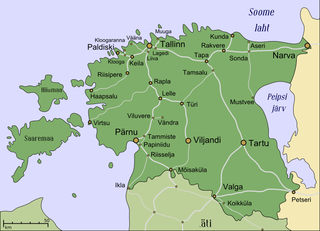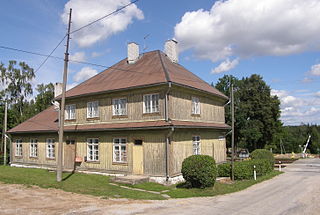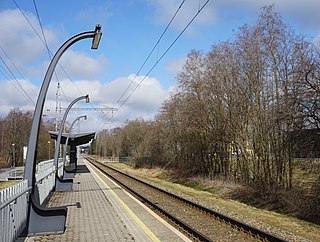
AS Eesti Liinirongid, operating as Elron, is a government-owned passenger train operator in Estonia.

The rail transport system in Estonia consists of about 1,200 kilometres (750 mi) of railway lines, of which 900 kilometres (560 mi) are currently in public use. The infrastructure of the railway network is mostly owned by the state and is regulated and surveyed by the Estonian Technical Surveillance Authority.

The history of rail transport in Estonia starts in 1870 when a railway line was opened connecting Paldiski, Tallinn, Tapa and Narva; the line extending all the way to Saint Petersburg in Russia.

Tartu railway station is the main railway station in Tartu, Estonia.

Lilleküla railway station is a railway station in the Kristiine district of Tallinn, the capital of Estonia. The station is situated between the subdistricts Lilleküla and Uus Maailm, and close to the Estonian national football home ground A. Le Coq Arena and Kristiine Keskus, one of the biggest and most popular shopping centres in Tallinn.

Koidula railway station is a railway station in Koidula, Estonia, on the Russian border. It merges the Tartu–Pechory and Valga–Pechory railways just before the Russian border. The station opened in September 2011, and is a few metres from the border with Russia. The main purpose of the station is making the crossing of Russian border easier for both goods and passengers. It also enabled the traffic on "Southeast Estonian Triangle" (Tartu–Valga–Piusa–Tartu) without crossing the Russian border. Currently however there are no cross-border passenger trains, and services from Pskov to Pechory do not connect with the Elron services in Estonia.

Kaarepere railway station is a historic railway station located in the village of Kassinurme near Kaarepere in eastern Estonia. The station is served by trains heading to Tallinn and Tartu operated by Elron

The Tallinn–Narva railway is a 211 km (131 mi) long railway line in Estonia which runs through Northern Estonia between Estonia's capital city Tallinn and the city of Narva on the border with Russia.

Ülemiste railway station is a railway station in the Ülemiste sub-district of Tallinn, the capital city of Estonia. It is located approximately 500 metres from Tallinn Airport, to which it has been connected by a tramline since 2017.

Kivimäe railway station is a railway station in the Nõmme district of Tallinn, Estonia. The station serves the Kivimäe sub-district which has approximately 4800 residents.

Pääsküla station is a railway station in Pääsküla in Nõmme district of Tallinn, Estonia, approximately 11 kilometers southwest from the Baltic station which is the main railway station of Tallinn, near the Baltic Sea. The Pääsküla railway station is located between Kivimäe and Laagri railway stops of Tallinn-Keila railway. The station was opened in 1915.

Laagri railway station is a station in the Nõmme district of Tallinn, Estonia. The railway station serves the Laagri sub-district of Nõmme and Laagri borough of Saue parish which in combination has approximately 6400 residents.

Hiiu railway station is a railway station in the Nõmme district of Tallinn, Estonia. The station serves the Hiiu sub-district which has approximately 3900 residents. It is located approximately 9 kilometers southwest from the Baltic station which is the main railway station of Tallinn, near the Baltic Sea. The Hiiu railway station is located between Nõmme and Kivimäe railway stations of Tallinn-Keila railway. The station was opened in 1926.

Nõmme railway station is a railway station in Nõmme, Tallinn, Estonia. The station serves the Nõmme sub-district which has approximately 6600 residents.

Rahumäe railway station is a railway station serving Rahumäe, a subdistrict of the Nõmme district of Tallinn, Estonia. Rahumäe has approximately 3000 residents.

Järve railway station is a railway station in the Kristiine district of Tallinn, Estonia. The station serves the Järve sub-district which has approximately 3000 residents.

Paldiski railway station is a railway station serving the town and Baltic Sea port of Paldiski, situated on the Pakri Peninsula of northwestern Estonia.

Kitseküla railway station is a railway station in the Kitseküla sub-district of Tallinn, the capital city of Estonia. It is located in central Tallinn, where the Tallinn–Narva railway crosses the road Pärnu maantee, and close to the East Tallinn Central Hospital and the Lilleküla Stadium. The station opened on 10 November 2008.

Saue railway station is a railway station serving the town of Saue in Saue Parish in Harju County in northern Estonia.

Valingu railway station is a railway station serving the village of Saue in Saue Parish in Harju County in northern Estonia.






















